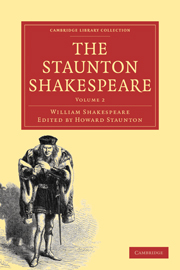Book contents
- Frontmatter
- Contents
- ALL'S WELL THAT ENDS WELL
- KING HENRY THE FIFTH
- AS YOU LIKE IT
- PERICLES, PRINCE OF TYRE
- TWELFTH NIGHT; OR, WHAT YOU WILL
- THE FIRST PART OF KING HENRY THE SIXTH
- THE SECOND PART OF KING HENRY THE SIXTH
- THE THIRD PART OF KING HENRY THE SIXTH
- TIMON OF ATHENS
- KING RICHARD THE THIRD
- MEASURE FOR MEASURE
- KING HENRY THE EIGHTH
- CYMBELINE
TWELFTH NIGHT; OR, WHAT YOU WILL
Published online by Cambridge University Press: 29 August 2010
- Frontmatter
- Contents
- ALL'S WELL THAT ENDS WELL
- KING HENRY THE FIFTH
- AS YOU LIKE IT
- PERICLES, PRINCE OF TYRE
- TWELFTH NIGHT; OR, WHAT YOU WILL
- THE FIRST PART OF KING HENRY THE SIXTH
- THE SECOND PART OF KING HENRY THE SIXTH
- THE THIRD PART OF KING HENRY THE SIXTH
- TIMON OF ATHENS
- KING RICHARD THE THIRD
- MEASURE FOR MEASURE
- KING HENRY THE EIGHTH
- CYMBELINE
Summary
This enchanting comedy was first printed in the folio of 1623, and no quarto edition of it has ever been found. Though long supposed, upon the authority of Malone and Chalmers, to have been one of Shakespeare's very latest productions, we now know that it was acted in the Middle Temple, as early as the beginning of the seventeenth century. This fact was first made public by Mr. Collier and Mr. Hunter, who discovered, almost simultaneously, a small manuscript diary, among the Harleian Collection in the library of the British Museum, which appears to have been made by a student of the Temple, named Manningham, and contains the following interesting entry :—
“Feb. 2, 1601 [2].
At our feast, wee had a play called Twelve Night or what you will, much like the Comedy of errors, or Menechmi in Plautus, but most like and neere to that in Italian, called Inganni. A good practice in it to make the steward believe his lady widdowe was in love with him by counterfayting a letter, as from his lady in general termes telling him what shee liked best in him, and prescribing his gestures, inscribing his apparaile, &c.; and then when he came to practice, making beleeve they tooke him to be mad.”
This is decisive, and, as there can be no doubt that, before being acted in the Temple, it had been represented in the public theatre, and, since it is not mentioned by Meres in his list of 1598, its production may be confidently ascribed to the period between that year and February, 1602.
- Type
- Chapter
- Information
- The Staunton Shakespeare , pp. 231 - 282Publisher: Cambridge University PressPrint publication year: 2009First published in: 1859

